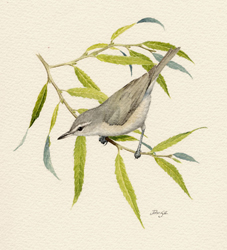Breeding Bird Atlases (BBA)
Find a Bird - BBA1
Breeding Bird Atlas 1 Species Accounts
Warbling Vireo
Vireo gilvus
Egg Dates
May 20 to late July
Number of Broods
one; may re-lay if first attempt fails.

The Warbling Vireo is a fairly common summer resident except on the southeastern coastal plain, Cape, and Islands, where it is essentially absent. During the nineteenth century and the first half of the present century, this species was commonly found in parks and villages, and along tree-lined lanes of country towns. Although still located in similar areas of some of the outlying suburbs and more rural areas, the Warbling Vireo is now more apt to be encountered along the semi-open borders of river meadows, ponds, and streams. This riparian habitat may be the one that this species originally occupied before European settlement and the subsequent three centuries of development.
The Warbling Vireo generally arrives from its wintering grounds in early to mid-May. Residents seek open areas with mature deciduous trees, particularly along watercourses, on which to establish their territories. The males begin singing as soon as they arrive and will continue their performance for several months.
The warbling song of this species is both melodious and rolling. It is often compared to the song of the Purple Finch but is less forceful and has an evenly measured tempo. The male Warbling Vireo is a persistent singer whose song is given not only at the beginning of the nesting cycle but throughout the nesting season as he shares the incubation chores. Although there may be a brief hiatus of song while the fledglings develop, singing is often begun anew in August and continues into September. A coarse zree-zree call note is often given. The second common call note, used by both adults and young, is a snip-snip likened to the sound produced by garden shears.
Courtship displays are seldom noted, but the male may spread its wings and tail and hop around the female while producing a very soft version of the song. The Warbling Vireo builds a small, deeply cupped nest with fine strips of bark, grasses, and plant down. Spider’s silk is often used to wrap and bind this structure, which may then be lined with grass or hair. The nest usually is constructed at a considerable height, up to 90 feet, but may be placed much lower. Heights of 7 Massachusetts nests ranged from 10 to 40 feet, with an average of 21 feet. Nests are placed on a horizontal branch among the leafy growth. In the Commonwealth, nests have been located in poplar, Quaking Aspen, White Ash, elm, linden, Silver Maple, Red Maple, American Beech, apple, and Pear (ACB, CNR).
Typically, four eggs (range three to five) constitute the clutch. Three state nests each contained four eggs (DKW). Incubation is by both sexes and averages 12 to 14 days, and the young leave the nest 12 to 14 days after hatching. A nest in Marshfield contained four young (CNR). Nestlings have been reported in Massachusetts from June 13 to August 6 and fledglings from June 27 to August 8 (CNR, Meservey). One brood is raised, but the birds will renest. Ornithologist Coues characterized the Warbling Vireo as “...oftener a voice than a visible presence.” Because of the species’ subtle gray-green coloration and the fact that much of the nesting and chick rearing takes place high in the canopy, Warbling Vireos are not easy subjects for observation.
Fall migrants move through Massachusetts during the latter part of August and the first half of September, during which time the local residents also depart. By the end of September, most Warbling Vireos have moved south of our area for their Mexican and Central American wintering grounds.
Map Legend and Data Summary
Atlas 1 data collected from 1975-1979


Note: locally common along major watercourses, less common elsewhere; virtually absent on southeastern coastal plain
Richard K. Walton



